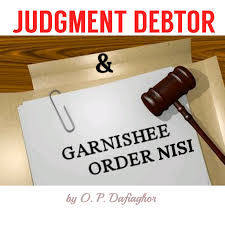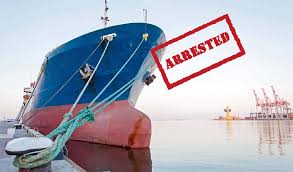
Introduction:
Business transactions sometimes do not always go as planned. Many business owners at a point in time find themselves in bad debt and deep financial crisis that becomes impossible to remedy.
Once an individual or business outfit runs into bad debt, which the creditor does not want to forfeit or cancel and in essence wants to recover back his debt from the debtor, the most appropriate and recommended legal means to recover the debt is to approach the law court for redress. The creditor usually initiates court action against the debtor for recovery of the loan sum or money owed the creditor and upon obtaining judgment in favour of the creditor, the process of garnishment of account of the judgment debtor is usually set in motion.
Thus, garnishee proceeding is initiated by a judgment creditor against a disclosed account of a judgment debtor. The word garnishee is derived from the French word “GARNISH” which simply connotes “to warn”.
Put in another way, it is the process by which execution or enforcement of monetary judgment whereby the money belonging to a judgment debtor in the possession of a third party called the Garnishee is attached or seized by a judgment creditor. See the case of UBN Plc v. Boney Marcus Industries Ltd. & Ors. (2005) All FWLR (Pt. 278) 1037 at 1046-1047.
Consequently, garnishee proceedings is a second stage of litigation in the recovery of debt after judgment has been obtained and is usually initiated where the judgment debtor refuses to obey or comply with the judgment of the court by not paying the awarded cost to the judgment creditor and most importantly fails to file an appeal against the judgment.
Finally, the circumstances under which garnishee proceedings are applicable is that the money must have been due or have accrued to the judgment debtor for it to be liable to garnishment and the judgment debtor has refused to pay. Also of note is that court judgment must have been obtained in favour of the creditor.
Meaning of the term “Garnishee”:
The term “garnishee” denotes a person or an institution (e.g. a bank) that is either indebted to, or is bailed for another, whose property has been subjected to garnishment. Also termed “garnishee-defendant”. See BLACK’S LAW DICTIONARY 8th edition 2004, at 703 thus:
“Garnishment is a[n] … inquisitorial proceeding, affording a harsh and extraordinary remedy. It is an anomaly, a statutory invention sui generis, with no affinity to any action known to the common law . . . . It is a method of seizure; but it is not a ‘levy’ in the usual acceptation of that term. It is a proceeding by which a diligent creditor may legally obtain preference over other creditors and it is in the nature of a creditor’s bill, or a sequestration of the effects of a debtor in the hands of his debtor. See also the case of C.B.N v. Auto Import Export & Anor (2012) LPELR-CA/L/677/2008.
Definition of “Garnishee Proceeding”:
Garnishee proceeding is a means by which judgment is enforced. It denotes that the judgment debtor is himself a creditor to another. Thus, the judgment creditor has to obtain an order of Court that the debtor pays the judgment creditor by the instrumentality of attaching the debt. See the case of In RE: Diamond Bank Ltd. (2002) 17 NWLR Pt.795 page 120 and Sokoto State Government v. Kamolex (Nig.) Ltd. (2004) 9 NWLR Pt.878 page 345.
The Black’s Law Dictionary, 5th Edition, page 612 has been defined as follows:
“A statutory proceeding whereby a person’s property, money, or credit in possession or under control of, or owing by, another are applied to payment of former debt to third person by proper statutory process against debtor and garnishee.”
The Court also in the case of STB LTD. v. Contract Resources (NIG.) Ltd. (2001) 6 NWLR (Pt. 708) p. 115 at p. 123, per Olagunju, JCA defined ‘garnishee’ as follows:
“…a garnishee is a third party who is indebted to the judgment debtor or having custody of his money and who at the instance of the judgment creditor is being called upon to pay the judgment debt from his indebtedness to the judgment debtor or from the creditor of the judgment debtor in his account with the third party.” See also the case of UBA Ltd. v. SGB Ltd. (1996) 10 NWLR (Pt. 478) pg. 381 at pg. 390, paras C-D.
Concept and procedure that governs garnishee proceedings:
Garnishee proceeding is a separate and distinct action between the judgment creditor and the person or body holding in custody the assets of the judgment debtor, although it follows from the judgment that pronounced the debt owing. Thus, a successful party, in his quest to move fast against the assets of the judgment debtor usually makes an application ex parte for a “garnishee order nisi” attaching the debt due or accruing to the judgment debtor from such person or body that from the moment of making the order is called the garnishee.
The following procedure governs garnishee proceedings, namely:
(a) The garnishee must be personally served with the garnishee order nisi;
(b) Upon effecting personal service of the order, the order binds the debt in the hands of the garnishee and he must therefore pay the debt over to the judgment creditor or such amount that will cover the judgment debt;
(c) If the garnishee wishes to dispute the debt or liability by it to the judgment debtors, he must appear before the court;
(d) Where the garnishee fails to appear in obedience to the court’s order, the court may proceed to make the order nisi absolute.
Garnishee Proceedings can be described in two stages as follows:
a. The first stage is the process of getting an Order Nisi.
The Order Nisi directs the Garnishee to appear in Court on a specified date to show cause why an order should not be made upon him for payment to the judgment creditor the amount of debt owed by the judgment debtor.
This is usually done ex-parte and limited to the judgment creditor and the Court.
b. The second stage is the hearing of the affidavit to show cause.
This is where on the return date the Garnishee does not attend, or does not dispute the debt claimed to be due from him to the judgment debtor, the Court may subject to certain restrictions, make the Garnishee Order absolute under which the garnishee is ordered to pay to the judgment creditor, or so much of it as it is sufficient to satisfy the judgment debt together with the cost of the proceedings and cost of garnishee.
This later proceedings is tripartite between the judgment debtor, judgment creditor and the garnishee. This is because on the return date, all parties must have been served and given opportunity to dispute liability or pray that the Order Nisi be discharged for one cause or the other.
The garnishee may dispute his liability to pay the debt. He will appear in Court on the return date and dispute the liability by denying indebtedness to the judgment debtor. He must make out a prima facie case in favour of an order for an issue to be tried.
Section 87 of the Sheriffs and Civil Process Act, Cap 407 Laws of the Federation of Nigeria 1990 states the position of the law that:-
“Where a garnishee disputes liability, the Court may then order that any issue or question necessary for determining his liability be determined or tried in any manner in which any issue or question in any proceedings may be tried or determined and may refer the matter to a referee.”
Purpose of garnishee proceedings:
The purpose of garnishee proceedings is to order a third party to pay direct to the judgment creditor the debt due or accruing from him to the judgment debtor or so much as may be sufficient to satisfy the amount of the judgment and the costs of the garnishee proceeding.
In essence, once an ex parte garnishee order nisi is sought and obtained by the judgment creditor, the judgment debtor as well as his financial institutions are notified of the pending order of court so as to show cause why an order absolute should not be granted by the court attaching various sums in their custody to defray the judgment debt. See the case of Aburime v. UBA Plc & Ors (2018) LPELR-CA/B/80/2013
Nature and procedure for Garnishee Proceedings:
Garnishee proceeding is a separate and distinct action between the judgment creditor and the person or body holding in custody the assets of the judgment debtor, although it follows from the judgment that pronounced the debt owing.
Thus, a successful party in his quest to move fast against the assets of the judgment debtor usually makes an application ex partefor a garnishee order nisi attaching the debt due or accruing to the judgment debtor from such person or body that, from the moment of making the order, is called the garnishee. See the cases of Re: Diamond Bank Ltd. (2002) 17 NWLR (Pt. 795) 120, C.B.N v. Interstella Comms. Ltd. (2015) 9 NWLR (Pt. 1462) 456 at 466, pp. 502, paras. D-F.
For the sake of clarity, Section 83(1) of the Sheriff and Civil Process Act, Cap S6 of 2004, provides:
“83 (1) – The Court may, upon the ex-parte application of any person who is entitled to the benefit of a judgment for the recovery or payment of money, either before or after any oral examination of the debtor liable under such judgment and upon affidavit by the applicant or his legal practitioner that judgment has been recovered and that it is still unsatisfied and to what amount, and that any other person is indebted to such debtor and is within the state, order that debts owing from such third person, hereinafter called the garnishee, to such debtor shall be attached to satisfy the judgment or order together with the costs of the garnishee proceedings and by the same or any subsequent order it may be ordered that the garnishee shall appear before the Court to show cause why he should not pay to the person who has obtained such judgment or order the debt due from him to such debtor or so much thereof as may be sufficient to satisfy the judgment or order together with costs aforesaid”.
In the case of UBN Plc v. Boney Marcus Ind. Ltd (2005) 13 NWLR (pt. 943) 654 @ 666, Akintan JSC stated thus:
“Garnishee proceedings are a process of enforcing a money judgment by the seizure or attachment of the debts due or accruing to the judgment debtor, which form part of his property available in execution by this process, the Court has power to order a third party to pay direct to the judgment creditor the debt due from him to the judgment debtor or as much of it as may be sufficient to satisfy the amount of the judgment and the cost of the garnishee proceedings”.
The import of garnishee proceedings is that a judgment debtor is merely a nominal party whose money in the custody of the garnishee is being recovered by the judgment creditor in satisfaction of the judgment debt he is owing to the judgment creditor. Thus, as held in the case of Fidelity Bank Plc v. Okwuolu & Anor. (2012) LPELR-8497 (CA) per Ogunwumiju JCA, stating that garnishee proceedings are sui generis, distinct from other proceedings for enforcement of judgment. Garnishee proceeding is ‘sui generis’, although it flows from the judgment that pronounced the debt. See also the case of Guaranty Trust Bank Plc v. Innoson Nigeria Limited (2014) LPELR CA/I/258/2011.
However, pursuant to the relevant provisions of the Sheriffs and Civil Process Act, garnishee proceeding is “sue generis” and a special one of its type. It is a separate and distinct procedure between the Judgment Creditor referred to as the Garnishor and the person or body known as the Garnishee, holding in his/its custody the assets of the judgment debtor. It is a procedure whereby, a successful party in an action in his quest to move quickly against the assets of the judgment debtor, initiates an application “ex parte” for a garnishee “Order Nisi” attaching the debt due or accruing to the judgment debtor from the Garnishee.
Under Section 83 of the Act, both the Garnishee and the Judgment Debtor must be served with the “Order Nisi”. In this regard, the judgment debtor is a mere nominal party in the garnishee proceedings “stricto sensu”, for the proceeding is between the Garnishor/Judgment Creditor and the Garnishee. As all the orders made by the Court in the course of the proceedings on the application of the Garnishor/Judgment Creditor are directed at the Garnishee and vice versa and not the Judgment Debtor.
In the case of: U.B.A. Plc. v. Boney Marcus Ind. Ltd. (2005) 13 NWLR (Pt.943) p.654 at p.666, paras. E-H, Akintan, JSC (Rtd.) succinctly crafted in the following words the implications of the special procedure, garnishee proceedings, to wit:
“Garnishee proceedings are a process of enforcing a money judgment by the seizure or attachment of the debts due or accruing to the judgment debtor which, form part of his property available in execution. It is therefore a specie of execution of debts for which the ordinary methods of execution are inapplicable. By this process, the Court has power to order a third party to pay direct to the judgment creditor the debt due or accruing due from him to the judgment debtor, or as much of it as may be sufficient to satisfy the amount of the judgment and the costs of the garnishee proceedings.” See Words & Phrases Legally defined, 3rd Edition, Vol. 2, pages 313 – 314. Applications for garnishee proceedings are made to the Court by the judgment creditor and the orders of the Court usually come in two steps.
Proper venue for garnishee proceedings:
Garnishee matters can only be initiated in a court where the judgment debtor can sue for the debt. See the case of C.B.N v. Auto Import Export (2013) 2 NWLR (Pt. 1337) 80, CBN v. Okeh Nig. Ltd. (2014) LPELR-23162.
A garnishee proceeding should be instituted where the defendant resides or carry on business. If the defendant is a corporate body, its residence depends on where its central management and control is, particularly, where its chief executive works.
What is expected of judgment creditor in garnishee proceedings:
What a judgment creditor is expected to do in a garnishee proceeding is to prove that the garnishee has the money of the judgment debtor. A garnishee order must clearly show that the judgment debtor is the garnishee’s creditor otherwise, it will not bind the garnishee.
Is it the business of garnishee to undertake to play the role of an advocate for a judgment debtor by trying to shield and protect the money of the judgment debtor:
It is not the business of a garnishee to undertake to play the role of an advocate for a judgment debtor by trying to shield and protect the money of the judgment debtor. See the case of Oceanic Bank Plc. v. Oladepo (2012) LPELR-19670
Options open to court where garnishee fails to comply with order nisi:
Where a garnishee fails to file an affidavit to show cause why a garnishee order nisi should not be made absolute, the court should proceed and make the order nisi to become absolute. The only way by which the garnishee can express dissatisfaction with the order is to appeal against it. See the cases of Omnia (Nig.) Ltd. v. Dyktrade Ltd. (2007) 15 NWLR (Pt. 1058) 576, U.B.A. Plc v. Ekanem (2009) LPELR-8428; Re: Diamond Bank Ltd. (2002) 17 NWLR (Pt. 795) 120.
Conclusion:
It must be noted that the nature of garnishee proceedings must be clearly understood to avoid any misapprehension. It is well settled that garnishee proceeding is a mode of enforcement of judgment of a court. Its nature was unmasked in the case of UBN Plc v. Boney Marcus Ind. Ltd. (2005) 13 NWLR (Pt. 943) 654. In that case the Supreme Court per Akintan JSC held that:
“Applications for Garnishee proceedings are made to the Court by the judgment creditor and the orders of the Court usually come in two steps. The first is Garnishee order nisi. Nisi is a Norman-French word and it means “unless”. It is therefore an order made at that stage, that the sum covered by the application be paid into Court or to the judgment creditor within a stated time unless there is some sufficient reason why the party on whom the order is directed is given why the payment ordered should not be made. If no sufficient reason appears, the Garnishee order is then made absolute and that ends the matter in that the party against whom the order absolute is made is liable to pay the amount specified in the order to the judgment creditor.”
It follows on established authorities that an order nisi is made to await if there is any sufficient and credible cause shown by the Garnishee why the order given temporarily will not be made absolute. Once a Garnishee files an affidavit evidence showing cause the cause shown must be carefully considered in the interest of justice to see if the cause is sufficient or not. If the cause shown from the evidence is sufficient the repercussion is a discharge of the order nisi and the Garnishee. If however the cause shown is not found sufficient or credible then the Court will go further and make the order nisi absolute.
See the cases of Ezeanah v. Atta (2004) 7 NWLR (Pt. 873) 468; Okeowo v. A.G. Ogun State (2010) 10 NWLR (Pt. 1219) 327; Jolayemi v. Olaoye (2004) 12 NWLR (Pt.887) 322; Ogolo v. Fubara (2003) 11 NWLR (PT. 831) 231 and Nkado v. Obiano (1997) 5 NWLR (PT. 58) 31.
For further legal assistance on garnishee proceeding and enforcement of judgments, do not hesitate to contact the author:

Kingsley Izimah, Esq.
Principal Partner,
Nomos Legal Practice
+234 (0) 806-809-5282
+234 (0) 805-101-9362
For insightful updates in law, follow us on our social media pages via:
LinkedIn at: https://www.linkedin.com/company/nomoslegalpractice
Twitter/X at: https://twitter.com/legalnomos
Facebook page at: https://web.facebook.com/nomoslegalpractice



